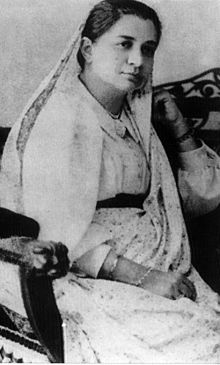Bhikaiji Cama
Madam Bhikaji Cama | |
|---|---|
 | |
| Born | 24 September 1861 |
| Died | 13 August 1936 (aged 74) |
| Organisation(s) | India House, Paris Indian Society, Indian National Congress |
| Movement | Indian independence movement |
| Spouse |
Rustom Cama (m. 1885) |
The design was adopted in 1914 as the emblem of the Berlin Committee (later known as the Indian Independence Committee). The original "Flag of Indian Independence" raised by Cama in Stuttgart is now on display at the Maratha and Kesari Library in Pune
Bhikaiji Rustom Cama[n 1] (24 September 1861 – 13 August 1936) or simply as, Madam Cama, was one of the prominent figures in the Indian independence movement.
Bhikaiji Cama was born in Bombay (now
She unfurled one of the earliest versions of flag of independent India on August 22, 1907 and she was the first person to hoist an Indian flag in a foreign nation, at the International Socialist Conference at Stuttgart.[2]
Like many Parsi girls of the time, Bhikhaiji attended Alexandra Girls' English Institution.[3] Bhikhaiji was by all accounts a diligent, disciplined child with a flair for languages.
On 3 August 1885, she married Rustom Cama, who was the son of
Activism
In October 1896, the
She was preparing to return to India in 1904 when she came in contact with
That same year Cama relocated to Paris, where—together with
On 22 August 1907, Cama attended the second Socialist Congress at Stuttgart, Germany, where she described the devastating effects of a famine that had struck the Indian subcontinent. In her appeal for human rights, equality and autonomy from Great Britain, she unfurled what she called the "Flag of Indian Independence".[n 2]
It has been speculated that this moment may have been an inspiration to African American writers and intellectuals W. E. B. Du Bois in writing his 1928 novel Dark Princess.[6] Cama's flag, a modification of the Calcutta Flag, was co-designed by Cama, and would later serve as one of the templates from which the current national flag of India was created.
In 1909, following Madan Lal Dhingra's
Influenced by
Exile and death
This section needs additional citations for verification. (March 2016) |
With the outbreak of
Cama remained in exile in Europe until 1935, when, gravely ill and paralyzed by a stroke that she had suffered earlier that year, she petitioned the British government through Sir Cowasji Jehangir to be allowed to return home. Writing from Paris on 24 June 1935, she acceded to the requirement that she renounce seditionist activities. Accompanied by Jehangir, she arrived in Bombay in November 1935 and died nine months later, aged 74, at Parsi General Hospital on 13 August 1936.[9]
Legacy


Bikhaiji Cama bequeathed most of her personal assets to the Avabai Petit Orphanage for girls, now the Bai Avabai Framji Petit Girls' High School, which established a trust in her name. Rs. 54,000 (1936: £39,300; $157,200) went to her family's
Several Indian cities have streets and places named after Bhikhaiji Cama, or Madame Cama as she is also known. On 26 January 1962, India's 11th Republic Day, the Indian Posts and Telegraphs Department issued a commemorative stamp in her honour.[11]
In 1997, the Indian Coast Guard commissioned a Priyadarshini-class fast patrol vessel ICGS Bikhaiji Cama after Bikhaiji Cama.
A high-rise office complex in the posh location of South Delhi which accommodates major Government Offices and companies such as
etc. is named as Bhikaji Cama Place in tribute to her.Following Cama's 1907 Stuttgart address, the flag she raised there was smuggled into
Further reading
- Sethna, Khorshed Adi (1987), Madam Bhikhaiji Rustom Cama, Builders of Modern India, New Delhi: Government of India Ministry of Information and Broadcasting
- Kumar, Raj; Devi, Rameshwari; Pruthi, Romila, eds. (1998), Madame Bhikhaiji Cama, (Women and the Indian Freedom Struggle, vol. 3), Jaipur: Pointer, ISBN 81-7132-162-3.
- Yadav, Bishamber Dayal; Bakshi, Shiri Ram (1992), Madam Cama: A True Nationalist, (Indian Freedom Fighters, vol. 31), New Delhi: Anmol, ISBN 81-7041-526-8.
Notes
- ^ Bhikhai- (with aspirated -kh-) is the name as it appears in the biographies. Another common form is Bhikai- (with unaspirated -k-), as it appears on the postage stamp. The name is also frequently misspelled 'Bhikha-' (with missing -i-), which is a male name (unlike the feminine Bhikhai-).
- ^ "This flag is of India's independence. Behold, it is born. It is already sanctified by the blood of martyred Indian youth. I call upon you, gentlemen, to rise and salute the flag of Indian independence. In the name of this flag, I appeal to lovers of freedom all over the world to cooperate with this flag in freeing one-fifth of the human race."
- ISBN 978-0-14-400038-8.
- ^ Pal, Sanchari (24 September 2016). "The Untold Story of Bhikaji Cama". The Better India.
- ^ Darukhanawala, Hormusji Dhunjishaw, ed. (1963), Parsi lustre on Indian soil, vol. 2, Bombay: G. Claridge.
- ISBN 978-0-19-151350-3. Retrieved 19 August 2013.
- ISBN 81-269-0639-1.
- S2CID 162273702.
- ISBN 81-7023-894-3
- ISBN 0-521-65377-0
- ISBN 1-58567-593-8
- ^ Dastur, Dolly, ed. (1994), "Mrs. Bhikaiji Rustom Cama", Journal of the Federation of Zoroastrian Associations of North America, 4.
- ^ India Post (1962), Bhikaiji Cama, Indian Post Commemorative Stamps, New Delhi
{{citation}}: CS1 maint: location missing publisher (link) - ^ Guha, Ramachandra (26 September 2004), "Truths about the Tricolor ur", The Hindu, archived from the original on 21 February 2011, retrieved 1 July 2020
{{citation}}: CS1 maint: unfit URL (link).
Further reading
- Gupta, Indra (2003), India's 50 Most Illustrious Women, New Delhi: Icon Publications, ISBN 81-88086-19-3.
